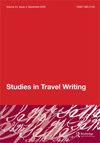Modes of transport and rhythms of mobility in Bernard B. Dadié’s Un Nègre à Paris (1959) and Tété-Michel Kpomassie’s L’Africain du Groenland (1981)
Q2 Arts and Humanities
引用次数: 0
Abstract
ABSTRACT This article discusses Bernard B. Dadié’s Un Nègre à Paris (1959; 1994) and Tété-Michel Kpomassie’s L’Africain du Groenland ([1981] (2015); 2001) by focusing on their portrayals of transport and rhythms of mobility, and in so doing enhances the dialogue between travel writing studies and mobilities research. The texts’ representations of mobility practices and the rhythms thereof contribute to the production of the traveller figure (tourist; Arctic adventurer) and the destination (colonial metropolis; Arctic periphery). Dadié’s portrayals of transport produce a poetics of mobility that conveys a sense of speed and hurry but also of not being in the rhythm of the colonial metropolis, which eventually transforms into a critical attitude towards assimilationist impulses. Kpomassie’s travelogue captures the idea of an unreachable destination and the traveller’s struggle to pursue the journey despite obstacles, but also attests to the productive qualities of inertia as well as to the eurythmy of Arctic mobilities.Bernard B. dadie的《巴黎的黑人》(1959)和tethe - michel kpomassie的《格陵兰的非洲人》(1981)中的交通模式和移动节奏
摘要本文讨论了Bernard B.Dadié的《巴黎》(1959;1994)和TéTé-Michel Kpomassie的《Groenland的非洲》([1981](2015);2001),重点关注他们对交通和流动节奏的描述,并以此加强旅行写作研究和流动性研究之间的对话。文本对流动实践的表现及其节奏有助于产生旅行者形象(游客;北极冒险家)和目的地(殖民地大都市;北极周边)。达迪对交通的描绘产生了一种流动性的诗学,它传达了一种速度感和匆忙感,但也传达了不在殖民大都市节奏中的感觉,这最终转变为对同化主义冲动的批判态度。Kpomassie的游记捕捉到了一个遥不可及的目的地的想法,以及旅行者不顾障碍努力追求旅程的过程,但也证明了惯性的生产力以及北极活动的艺术性。
本文章由计算机程序翻译,如有差异,请以英文原文为准。
求助全文
约1分钟内获得全文
求助全文
来源期刊

Studies in Travel Writing
Arts and Humanities-Literature and Literary Theory
CiteScore
0.40
自引率
0.00%
发文量
13
期刊介绍:
Founded in 1997 by Tim Youngs, Studies in Travel Writing is an international, refereed journal dedicated to research on travel texts and to scholarly approaches to them. Unrestricted by period or region of study, the journal allows for specific contexts of travel writing to be established and for the application of a range of scholarly and critical approaches. It welcomes contributions from within, between or across academic disciplines; from senior scholars and from those at the start of their careers. It also publishes original interviews with travel writers, special themed issues, and book reviews.
 求助内容:
求助内容: 应助结果提醒方式:
应助结果提醒方式:


